The Intel Xeon W-3175X Review: 28 Unlocked Cores, $2999
by Ian Cutress on January 30, 2019 9:00 AM ESTGaming: Ashes Classic (DX12)
Seen as the holy child of DirectX12, Ashes of the Singularity (AoTS, or just Ashes) has been the first title to actively go explore as many of the DirectX12 features as it possibly can. Stardock, the developer behind the Nitrous engine which powers the game, has ensured that the real-time strategy title takes advantage of multiple cores and multiple graphics cards, in as many configurations as possible.
As a real-time strategy title, Ashes is all about responsiveness during both wide open shots but also concentrated battles. With DirectX12 at the helm, the ability to implement more draw calls per second allows the engine to work with substantial unit depth and effects that other RTS titles had to rely on combined draw calls to achieve, making some combined unit structures ultimately very rigid.
Stardock clearly understand the importance of an in-game benchmark, ensuring that such a tool was available and capable from day one, especially with all the additional DX12 features used and being able to characterize how they affected the title for the developer was important. The in-game benchmark performs a four minute fixed seed battle environment with a variety of shots, and outputs a vast amount of data to analyze.
For our benchmark, we run Ashes Classic: an older version of the game before the Escalation update. The reason for this is that this is easier to automate, without a splash screen, but still has a strong visual fidelity to test.
| AnandTech CPU Gaming 2019 Game List | ||||||||
| Game | Genre | Release Date | API | IGP | Low | Med | High | |
| Ashes: Classic | RTS | Mar 2016 |
DX12 | 720p Standard |
1080p Standard |
1440p Standard |
4K Standard |
|
Ashes has dropdown options for MSAA, Light Quality, Object Quality, Shading Samples, Shadow Quality, Textures, and separate options for the terrain. There are several presents, from Very Low to Extreme: we run our benchmarks at the above settings, and take the frame-time output for our average and percentile numbers.
[game list table]
All of our benchmark results can also be found in our benchmark engine, Bench.
| Ashes: Classic | IGP | Low | Medium | High |
| Average FPS | 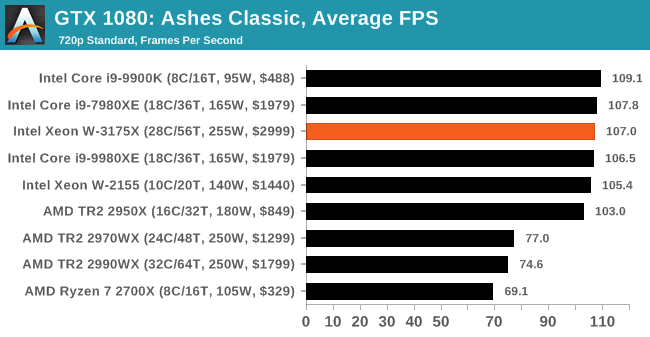 |
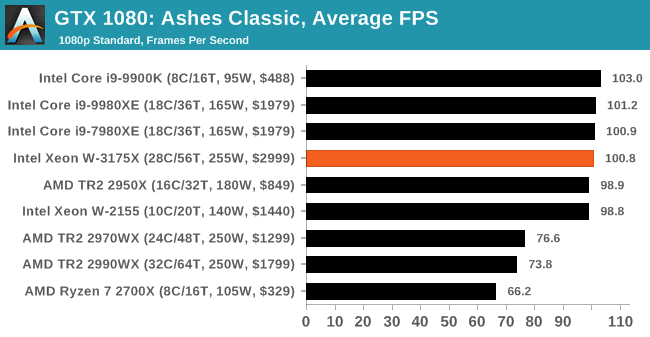 |
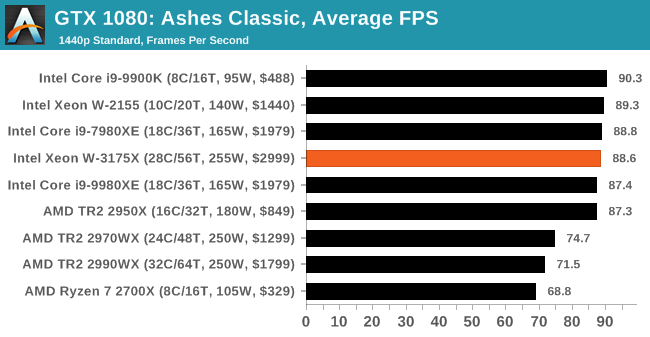 |
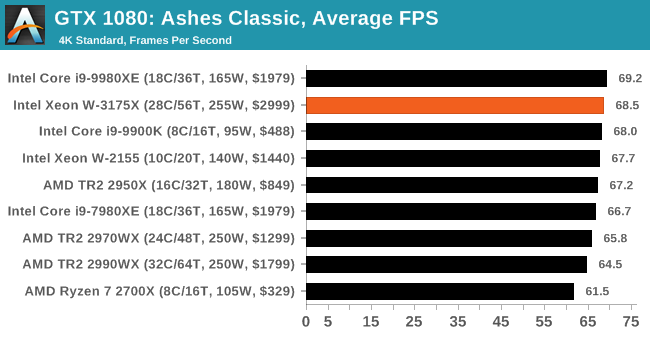 |
| 95th Percentile | 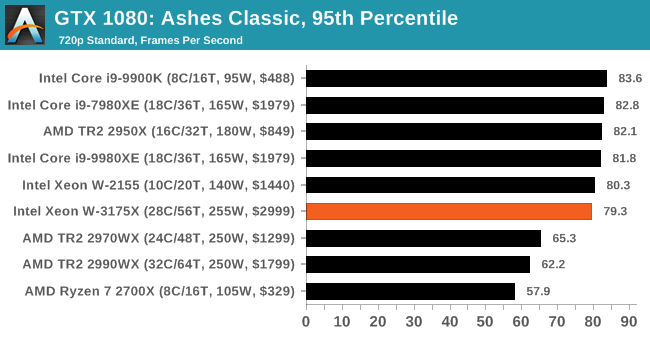 |
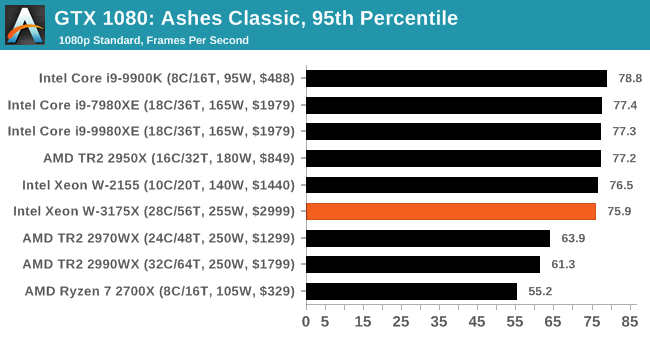 |
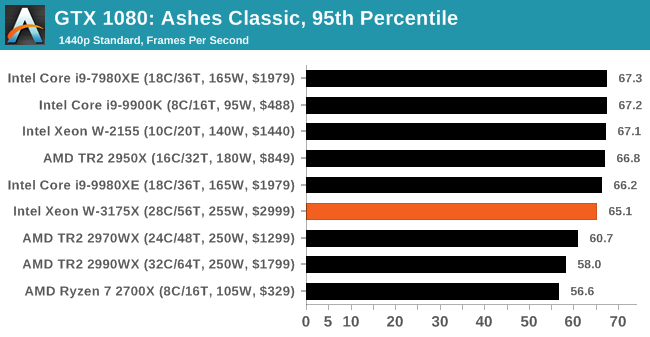 |
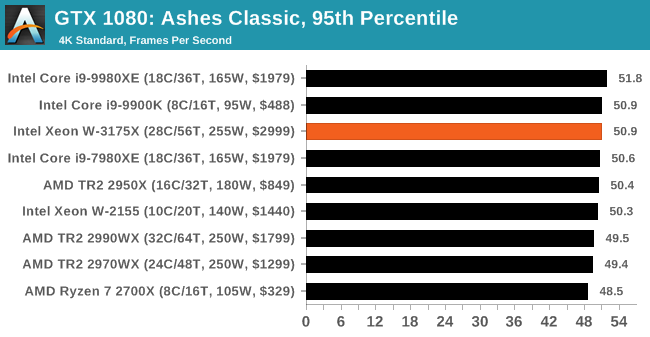 |
.


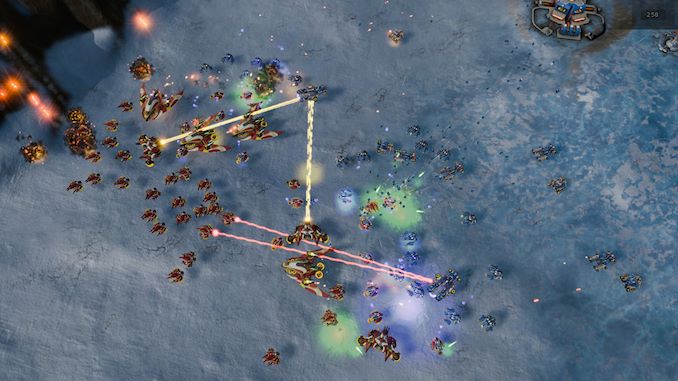









136 Comments
View All Comments
silverblue - Thursday, January 31, 2019 - link
Future bought the bulk of Purch not too long ago, but if it's same old same old, then I agree.Cooe - Wednesday, January 30, 2019 - link
Until these benches are all repeated in Linux all of these results are wortheless. Nobody would buy these CPU's for a Windows machine, and the 2990WX is totally borked by running in Windows as well.WasHopingForAnHonestReview - Wednesday, January 30, 2019 - link
True but the 2990WX is 1300$ cheaper and gives roughly the same performance. No one is going to buy this intel chip unless they have money to burn.maroon1 - Wednesday, January 30, 2019 - link
Same performance ?! Did you look a the benchmarks ?! w-3175x is cleary winning in majority of benchmarks (and some benchmarks should big advantage for w-3175x)I agree about price, but performance is not same
MattZN - Wednesday, January 30, 2019 - link
It depends on what precise application(s) you are running. But yes, the performance is about the same. Those benchmarks are pretty broken for a host of reasons... windows scheduler nonwithstanding, looking at a bunch of benchmarks doesn't really tell you a whole lot about how a machine will work in your actual environment.All that matters is whether the machine's performance affects your workflow in a noticeable way or not. Nobody is going to justify buying something like this if all they get out of it is a 15 minute faster encoding on a 2-hour job. Imagine that! Let alone a few seconds here and there, or a slightly slower or faster frame rate. For longer jobs you'll notice if something takes half the time. You won't notice if something is 20% slower or 20% faster. You just won't.
Many video encoding workloads are GPU accelerated, for example. Many are run as overnight batches, for example. If you go through all the benchmarks in this article, almost none of them are even remotely relevant to actual use cases. The Blender one maybe, Handbrake, and Adobe Premier and that's just about it. And surprise, surprise, the TR2950X or TR2990WX actually wins some of those.
For example, does anyone actually care how fast 7-zip runs? I sure as heck don't! I zip something up, it's well neigh instantaneous on just about any machine. Encryption? Nobody cares, it isn't a use case that anyone will notice. Office applications like spreadsheets? Come on... that's ridiculous. A 2-core mobile CPU can update a spreadsheet just as fast as one of these behemoths.
-Matt
GreenReaper - Thursday, January 31, 2019 - link
It does kinda matter for server-level ctivities. Say you have a SQL dump that you want to backup without using too much transfer. You can't run nightly backups until it's done. Even compressed it's 4GB. I use xz but it's essentially the same as 7-zip. More threads and faster threads can make a significant difference in run time, and in turn this impacts when you can backup or how much data you can handle on the system.I think you may be mistaken about the 20% difference if it effectively means you have to pay 20% more people. The question, as always, is is the price and other costs associated worth the improvement.
FMinus - Friday, February 1, 2019 - link
Why would you do any of that on this chip that sucks 600W, for all of your listed task a dedicated server chip would be better, you run them in batches over night as said, so the speed really does not matter at that point.This chip here is intended as a workstation work horse, and yes, with the price of the single chip and the expensive motherboards (which we still don't know if they will be available to the end-user directly) makes this an quite pointless platform, except if you are running Adobe Premiere 24/7.
For everything else you are better of with the cheaper AMD and Intel solutions, and you can get multiple systems of those for the price of one of these 3175X systems, split the work load or make them work together and they deliver faster results.
tamalero - Friday, February 1, 2019 - link
Not everyone has access to full blown server rendering farms. A lot of remote workers or freelancers would render with this "behemoth". Not everyone can blow 10,000 USD to have a bunch of EPYC servers just standing by.Still.. This thing doesnt seem THAT good compared to AMD's (both price, performance and power usage) to justify it.
only the AVX512 benches I guess.
But then.. Zen2 is supposed to double the output of AVX if I remember correctly.
WasHopingForAnHonestReview - Thursday, January 31, 2019 - link
7zip and some specific renders... The time saving isnt much. Its not even close to make this a worthwhile buy. When you take into account the windows scheduler bug fix coming... The amd TR for $1300 is still the obvious winner.eddman - Wednesday, January 30, 2019 - link
"No one is going to buy this intel chip unless they have money to burn."So it's not "No one" then.
I suppose 3D modeling and rendering studios or individuals that have lots of customers will probably be quite ok with buying these. That price is nothing compared to their income. They probably care more about reducing rendering time than saving a few thousand dollars, which they can recoup in probably a week or two.